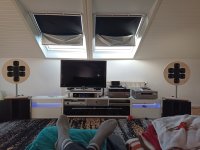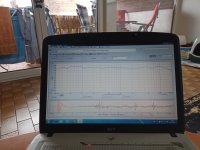Thanks - but I don't have any rear/side tweeter anymore🙂Effect of extra rear/side drivers visualized best with decay or wavelet graphs. I use REW where these are available with adjustable parameters
Hi,
I made a q&d cell phone demo record (different, experimental baffle).
I know, it's difficult, but comments are much appreciated, especially @ScottG , because he has much experience in this:
I made a q&d cell phone demo record (different, experimental baffle).
I know, it's difficult, but comments are much appreciated, especially @ScottG , because he has much experience in this:
Last edited:
Msny thanks, luckily I have ears and they stop my mouth from running around my head as I grin broadly 😀
It’s good, and the harmonic’s (overall) and upper bass “punch” is particularly good and depth is also quite good.
So, what is lacking on an absolute basis?
treble is less distinct (> about 1.5kHz) particularly with more extended bandwidth instrumentals (as with the piano in that track). It’s also a bit *forward relative to the rest of the freq. range (again the piano at higher freq.s is forward of most other images). Finally, stereo width is a bit compressed with images “bunched up” laterally (images “squeezed“ toward the center), and there isn’t much expansion of images to the outer-boundaries of the loudspeakers position. ..and of course deep bass is also lacking (though expected), most notably on that track with hall sound dimensions.
Basically a tweeter with a minimal or no baffle on top of the current baffle that’s well integrated above 2 kHz should give it that final “push” to excellence. ..those GRS PT2522’s.
Still, it’s very good as it is and you might screw-up some of that harmonic “richness” chasing after a better treble result.
*note: the treble balance sounds good, it doesn’t sound like the treble is elevated in Spl relative to the rest of the freq. range; instead this forward character is more about radiation pattern and diffraction.
So, what is lacking on an absolute basis?
treble is less distinct (> about 1.5kHz) particularly with more extended bandwidth instrumentals (as with the piano in that track). It’s also a bit *forward relative to the rest of the freq. range (again the piano at higher freq.s is forward of most other images). Finally, stereo width is a bit compressed with images “bunched up” laterally (images “squeezed“ toward the center), and there isn’t much expansion of images to the outer-boundaries of the loudspeakers position. ..and of course deep bass is also lacking (though expected), most notably on that track with hall sound dimensions.
Basically a tweeter with a minimal or no baffle on top of the current baffle that’s well integrated above 2 kHz should give it that final “push” to excellence. ..those GRS PT2522’s.
Still, it’s very good as it is and you might screw-up some of that harmonic “richness” chasing after a better treble result.
*note: the treble balance sounds good, it doesn’t sound like the treble is elevated in Spl relative to the rest of the freq. range; instead this forward character is more about radiation pattern and diffraction.
Last edited:
Many thanks Scott, much appreciated!
Yes, especially piano (but also a singers voice in this frequency range) is somewhat forward and I don't know if it's the speaker itself (shouty?), but I try to tame it, that's why I try this baffle, it helps to get a more civilized behavior. But - it causes a not so wide stage. So I will try again.
Deep bass lacking - yes, it was expected.
Earlier I used a tweeter, but it's not easy to integrate it into the xo because of the impedance. But I will give it a go again.
It's still fun
Yes, especially piano (but also a singers voice in this frequency range) is somewhat forward and I don't know if it's the speaker itself (shouty?), but I try to tame it, that's why I try this baffle, it helps to get a more civilized behavior. But - it causes a not so wide stage. So I will try again.
Deep bass lacking - yes, it was expected.
Earlier I used a tweeter, but it's not easy to integrate it into the xo because of the impedance. But I will give it a go again.
It's still fun

You know, you could always go active with the tweeter - even digitally for correction. Most people don’t think of this, instead in relation to bass freq.s only, but it is a viable option.
Yes, I think it's not an spl issue, based on the frequency response:*note: the treble balance sounds good, it doesn’t sound like the treble is elevated in Spl relative to the rest of the freq. range; instead this forward character is more about radiation pattern and didiffraction.
That's why I changed the position of the FR driver and it helped to a certain extent, this "piano-range" was even more forward in earlier versions. I think I could play with the placement, with covering the rear side of the baffle with acoustic foam, and I could try to lower the spl with a flat LRC-pad at about 1.5 kHz with about 3-4 dB (I'm just curious how it works).
Many thanks!@Plott your clip is sounding outstanding even on my headphones, congratulations.
Please share the details your new baffle, drivers and crossover as I am using a Fane 250TC driver with no additional woofer on a 4"x2" single baffle as OB experiments.
Thanks
I will report everything when this small issues are solved, I promise 🙂
I know but I'm not a DSP guy. I could make an active xo only for the tweeter, however. But at first I'll try conservative 🙂You know, you could always go active with the tweeter - even digitally for correction. Most people don’t think of this, instead in relation to bass freq.s only, but it is a viable option.
1.4 kHz is a little high relative to the average (and would likely sound better if lowered - without causing any other problem), but it’s narrow enough that I don’t think that is what’s causing most of the forward effect (unless the piano notes are all concentrated in that narrow bandwidth). Don’t know. 😱 

Yeah mediocre digital can screw-up the sound, but it might not be particularly noticeable 2kHz up in this context, particularly if your full range driver’s low-pass is analog and low order (1st order).I know but I'm not a DSP guy. I could make an active xo only for the tweeter, however. But at first I'll try conservative 🙂
If you’ve got the hardware already then it might be worth an attempt, also note that the partnering amplifier for the tweeter can be critical to the result, usually more so than most digital processing.
I made a quick sim for the 1.4 k issue and for the tweeter - I have all the parts so I think I will try it tomorrow.
And I will report, of course.
And I will report, of course.
Hi
Just finished an experimental ob coaxial array, was pleasantly surprised by the good sound, together with my 2 Disubs, they create a nice response....slight loudness effect, but I like it...
Cheers.
Just finished an experimental ob coaxial array, was pleasantly surprised by the good sound, together with my 2 Disubs, they create a nice response....slight loudness effect, but I like it...
Cheers.
Attachments
Hi again,
xo now modified, LRC added, here is the fr response and a cell phone demo record, same song, same volume.
I think it's more civilized, but somewhat too relaxed - or am I just used to the more forward sound?

xo now modified, LRC added, here is the fr response and a cell phone demo record, same song, same volume.
I think it's more civilized, but somewhat too relaxed - or am I just used to the more forward sound?
That’s better if a bit less pin-point for some of the bandwidth. Note: the images gets a bit more “phasey” as it does in reality - as it “plays” to the acoustics of the room (in the recording) and “blooms” outward (providing both a deeper and wider sound).
Cymbals are also notably better with the raised treble response.
It will be interesting to hear what the result is with the active tweeter, I’m guessing that you’ll get back some of that loss of “focus” - probably with even better image positioning.
Cymbals are also notably better with the raised treble response.
It will be interesting to hear what the result is with the active tweeter, I’m guessing that you’ll get back some of that loss of “focus” - probably with even better image positioning.
Last edited:
Thanks Scott!
"Cymbals are also notably better with the raised treble response." Yes, that's my biggest concern too, the liveliness is gone to a certain extent.
Passive crossed tweeter follows tomorrow 👍 active... will see.
"Cymbals are also notably better with the raised treble response." Yes, that's my biggest concern too, the liveliness is gone to a certain extent.
Passive crossed tweeter follows tomorrow 👍 active... will see.
Hi,
now with a PT2522-4 crossed @~5 kHz, original baffle.
I like it 🙂 But the slight bump at 1.4 kHz is here, again.
now with a PT2522-4 crossed @~5 kHz, original baffle.
I like it 🙂 But the slight bump at 1.4 kHz is here, again.
- Home
- Loudspeakers
- Multi-Way
- My open baffle journey

